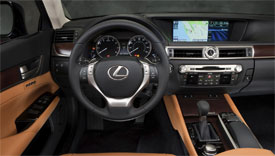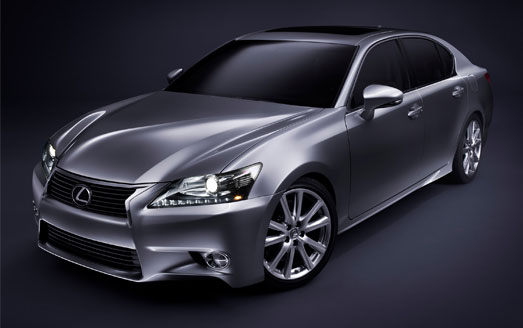2013 Lexus GS 350
Lexus is on a mission, to shed their image of building cars that are very luxurious and high tech, but boring to drive. First came the compact IS-F, than the exotic LFA, and now they’re turning their attention to a car with wider appeal, the mid-size GS sport sedan. So, is the latest GS a Lexus reborn?
With the fourth generation 2013 GS 350, Lexus does appear to break from their luxury-overload mold. Not that the rear drive GS has been a snoozer. Truth be told, the previous GS was already fast, and more entertaining to drive than most people gave it credit for. The biggest problem was electronic, with one of the most aggressive and intrusive stability control systems on the market that quickly kept you from having any real fun. So, the fix was more of a software one than hardware. Not that the hardware hasn’t changed.
 The 2013’s body and chassis are all-new. And, the sheet metal is undeniably more aggressive… at least from the front, with huge air intakes that widen towards the pavement, menacing HID headlights with LED running lights, and LFA inspired curves. In profile, the look is more familiar, with smooth sides and thick C-pillars, leading to a rear end that is tall with a trunk-lip spoiler, L-shaped tail lamps with lens mounted fins, and an aggressive lower fascia with integrated dual exhausts.
The 2013’s body and chassis are all-new. And, the sheet metal is undeniably more aggressive… at least from the front, with huge air intakes that widen towards the pavement, menacing HID headlights with LED running lights, and LFA inspired curves. In profile, the look is more familiar, with smooth sides and thick C-pillars, leading to a rear end that is tall with a trunk-lip spoiler, L-shaped tail lamps with lens mounted fins, and an aggressive lower fascia with integrated dual exhausts.
Feeding those pipes is a slightly revised 3.5-liter V6. Horsepower and torque are up marginally, to 306-horsepower and 277 pound feet; Lexus puts 0-60 at 5.7 seconds. There are no plans for a V8, but engineers added an Intake Sound Generator that sounds like one. The GS 450h Hybrid will boast 338-horsepower. A revised, paddle-shift 6-speed automatic is standard. New is drive-mode selector with ECO, Sport, and Sport Plus settings. All wheel drive is once again an option.
With all this, plus endless Lexus hype, we knew the GS would outperform its predecessor. But, on our first drive even we jaded journalists were impressed with the improved handling. This new found prowess still relies heavily on electronics however, mainly a new Adaptive Variable Suspension. To that, add Electric Power Steering, Dynamic Handling with Variable Gear Ratio Steering, Dynamic Rear Steering, and Vehicle Dynamics Integrated Management.
But, the most important difference for the new GS, is genuine feel and feedback, which in itself is game changing. Sure, even with the upgraded F-Sport Package, there are times when the car’s handling is not telegraphic, but also in un-Lexus-like fashion, you can turn all the electronic traction nannies off!
Looking around the inside of the new GS, its still classic Lexus, but with a nod to the best from BMW. High end leather abounds, with contrasting stitching on the dash. The wood and leather wheel features many controls, and can be heated. The Lexus remote touch central controller still manages most functions, but it now has a more convenient push-to-enter design. The optional nav system grows a hooded center screen from 8 to 12 inches. And, for as big as it is, it never seemed intrusive. Voice activation is included.
 Gauges look 3-D with lighting that changes from ECO Blue to Angry Red in Sport Mode. Our GS Luxury was equipped with just about every amenity you could imagine, head-up display, blind spot monitoring, night vision, window shades all around, and comfortable, heated-and-cooled, 18-way power adjustable front seats. Even rear seat occupants get coddled with flip down armrest controls for heated seats, climate, and audio. Leg room is up thanks to redesigned front seats. The trunk is also roomier, due to a more compact rear suspension. Capacity is up to 14.3-cubic feet.
Gauges look 3-D with lighting that changes from ECO Blue to Angry Red in Sport Mode. Our GS Luxury was equipped with just about every amenity you could imagine, head-up display, blind spot monitoring, night vision, window shades all around, and comfortable, heated-and-cooled, 18-way power adjustable front seats. Even rear seat occupants get coddled with flip down armrest controls for heated seats, climate, and audio. Leg room is up thanks to redesigned front seats. The trunk is also roomier, due to a more compact rear suspension. Capacity is up to 14.3-cubic feet.
Government Fuel Economy Ratings haven’t been released yet, but estimates are 19-City and 23-Highway on Premium. Nor is pricing set, but when sales start in February, expect the GS 350 sticker to start about where it does now, near $48,000.
While the 2013 Lexus GS 350 is undeniably more capable and fun to drive, it still falls short of providing the absolute feedback of European and even American rivals. The F-Sport model is more serious; but outside of wheels, tires, and brakes even it relies mostly on electronics for its increased capabilities. We’re not saying that that’s wrong, but engineering “feel” is a lot harder than engineering “performance.” So, Lexus, the new GS is a big step in the right direction. Now, let’s take a few more.
Specifications
- Horsepower: 306
- Torque: 277 lb-ft.
- 0-60 mph: 5.7 seconds
- EPA: 19 mpg city/ 23 mpg highway
2024 Polestar 2
More Range And More Power For The Polestar 2
Volvo is well on their way to making the transition to an all-electric brand, but their sister-brand Polestar is already there. Now, we’ve spent lots of time in their all-wheel drive, five-door Polestar 2, having tested it in 2021, and a year later when a two-wheel drive version arrived. But, EV updates are coming quickly. So, let us be your guide for all that’s new with the Polestar 2.
While we are driving more EVs than ever, we’ve also been spending a lot of time recently circling back to ones we’ve previously tested. As in this new era of electrified vehicles, significant updates are arriving quickly, with R&D investments increasing and retrofitting them easier than ever. This is often done through software updates that can even be accomplished over the air. For 2024, the Polestar 2 has indeed gotten some software updates, but some physical ones as well.
Clearly aimed directly at Tesla’s Model 3 when it arrived; the Polestar 2’s build quality was vastly better, but range definitely came up short. So, addressing that was priority No. 1; and for ’24 the Polestar can travel up to 20% farther than before while consuming 9% less energy, and when it comes time to charge it back up, it can do that 34% faster too.
Range in the Single Motor version increases from a max of 270 to 320 miles thanks to a larger 82-kWh battery pack, and that solitary motor now powers the rear wheels, not the front wheels. It’s also bigger, coming in at 220 kW compared to the previous 170 kW front-wheel drive version, going from 231 to 299 horsepower.
Dual Motors keep the same 78-kWh battery, but still sees a boost from 260 to 276 miles and takes advantage of the larger rear motor for a new combined 310-kW output with 421 horsepower. Our test car has the added Performance Pack, which uses an additional 35 kW to deliver 455 horsepower and 546 lb-ft of torque, though max range drops to just 247 miles.
The new battery in rear-drive 2s will also charge faster, now accepting up to 205 kW for an 80% charge in 20 minutes; max for dual-motors stays at 155 kW, which puts an 80% charge at 34 minutes. Using 32 kWh of electricity per 100 miles, the Dual Motor earns a good efficiency rating.
The [Polestar] 2 has always been one of the most enjoyable EVs to drive, even more so now with that additional power coming from the rear motor.
Unfortunately, extremely cold temperatures kept us from seeing that increased range, as we were only on pace for about 194 miles in our test.
The 2 has always been one of the most enjoyable EVs to drive, even more so now with that additional power coming from the rear motor. And especially when equipped with the Performance Pack as it not only includes more power, but adds 20-inch forged wheels, upgraded brakes, and adjustable Ohlins Dual Flow Valve performance dampers. It greatly improves handling prowess without affecting ride quality, and is easily worth the $5,500 charge if you at all enjoy driving.
Even on a 20-degree track day there was plenty of grip through our handling course. No understeer or oversteer, and lots of feedback through the wheel. There was a nice, strong launch off the line that properly planted us firmly in the seat, and rocketed us to 60 in 4.5 seconds. Power delivery stayed pretty intense up until about 80 mph when there was a definite tapering off. Still, it was a 13.4-second quarter-mile at 102 mph; smooth, quiet, and stable the whole way.
When this car debuted, its Google-based infotainment setup was a novelty, but since then, more and more manufacturers are just “Googling it” so it doesn’t seem out of place at all. The wireless phone charger is easy to access, and there’s a great Harmon/Kardon sound system and panoramic sunroof to enhance the in-cabin experience. Exteriors have also been enhanced with a smooth grille insert and new wheel choices.
Hatchback practicality means 14.3 cu-ft of easy to access cargo space with split-folding seatbacks for longer items and expanding the space to 38.7 cu-ft. Plus, there’s even a sizeable storage bin up front under the hood.
Single Motor Polestar 2 pricing now starts at $51,300, with Dual Motors starting at $56,700; topping out at $64,400.
For a car manufacturer that hasn’t even been around for a decade yet, Polestar has kept itself busy, totally transforming their latest model in just a few years, making the 2024 Polestar 2 even more appealing. They are certainly off to a good start, and with a host of Polestars just over the horizon, including some all-important utility vehicles, this star will be shining even brighter.
Specifications
As Tested
- Motor Setup: Dual Motor
- Horsepower: 455
- 0-60 mph: 4.5 seconds
- EPA Range: 247 miles
- Efficiency : 32 kWh / 100 miles
- Battery Size: 78-kWh
- Torque: 546 lb-ft
- 1/4 Mile: 13.4 seconds at 102 mph
- MW Test Loop: ~ 194 miles
- Peak Charging Rate: 155 kW











































